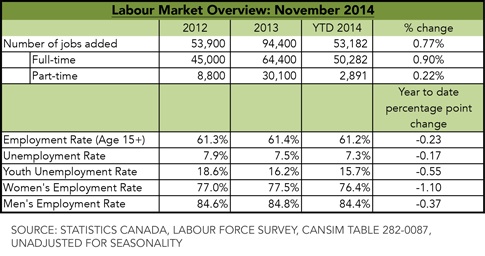After a gain of 37,000 jobs in October, Ontario posted a loss of 33,900 jobs in November.
Unfortunately, 80 per cent of those losses were in full-time work.
Ontario’s year-to-date unemployment rate is now 7.3 per cent. The province’s employment rate, which provides a snapshot of how many people are actually working in paid employment, nudged down a bit: year-to-date, Ontario’s employment rate is 61.2 per cent. To put that into perspective, the employment rate in 2012, post-recession, was 61.3 per cent and in 2013 it was 61.4 per cent.
The November job numbers run counter to an overall trend in 2014: the year featured nine months of net job growth and two months of net job losses.
Involuntary part-time work in Ontario continued to climb in November: one-third of all people who are working part-time in Ontario would rather be working full-time.
Going concern: Windsor remains home to the highest unemployment rate in the province at 7.9 per cent, followed closely by Toronto at 7.5 per cent.
A green shoot of hope: Youth unemployment was lower in 2014 than in the previous two years — though at 15.7 per cent, youth unemployment in Ontario remains twice as high as the overall unemployment rate.

Kaylie Tiessen is an economist with the Ontario office of the Canadian Centre for Policy Alternatives (CCPA-Ontario). Follow her on Twitter @KaylieTiessen.




